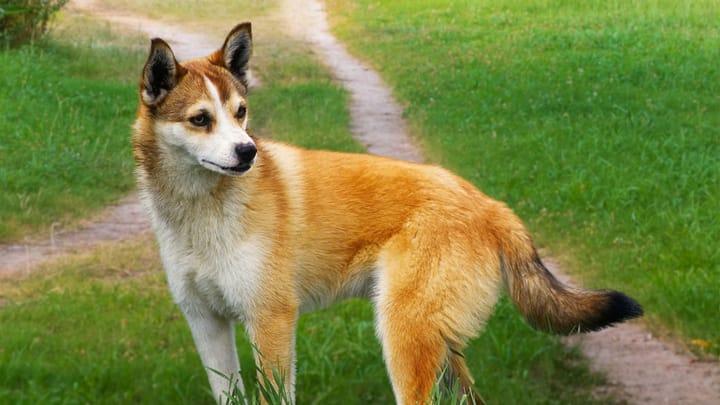Norwegian Lundehund
Other names : Norwegian Puffin Dog, Norsk Lundehund

The Norwegian Lundehund is a small spitz breed. It gets its name from a combination of two Norwegian words which mean puffin (Lunde) and dog (Hund). In other words, it’s the puffin dog. It earned this name after being used to hunt Puffin birds and their eggs. They would often navigate narrow cliff paths in search of their prey. This would be very risky for most dogs, but the Lundehund actually has six toes, giving them extra grip and balance when traversing narrow cliff paths and rugged terrain.
|
Life expectancy |
The Norwegian Lundehund has a life expectancy of between 11 and 13 years |
|
Temperament |
|
|
Size |
Small
|
|
Adult size |
Female
Between 13 and 14 in
Male
Between 14 and 15 in
|
|
Adult weight |
Female
Between 11 and 15 lb
Male
Between 13 and 18 lb
|
|
Coat colour
Reddish-brown to fawn with black hair tips; black or gray with white markings; white with dark markings. |
White Red Sand |
|
Type of coat
Medium-length, dense, rough topcoat. Thick, soft undercoat. |
Long |
|
Eye colour
Brown. |
Brown
|
|
Purchase price |
The Norwegian Lundehund costs between £1600 and £1800 |
A very expensive breed. People in the UK should expect to pay up to £2,000 for a purebred pup.
Due to inbreeding, there is a high rate of puppy mortality. Only purchase from a well-established and reputable breeder. Any pups being sold “cheaply” should be avoided.
More details about the Norwegian Lundehund
Norwegian Lundehund: Origins and history
The Norwegian Lundehund has been a valuable working dog for hundreds of years. It’s been helping Scandinavian hunters ever since the Viking Ages and became especially popular during the 16th and 17th century. Its flexible body and extra toes were ideal for navigating the cliff side regions of Norway, the natural habitat of the puffin bird. However, as new commercial hunting methods were adopted in the 20th century, the Lundehund’s numbers began to decline. This was exasperated by the introduction of a dog tax in Norway to deter hunters who were still using the traditional methods. The breed was decimated around the 1950s after an outbreak of a viral disease called canine distemper. It's thought that at one point there were less than six surviving Lundehunds. Today's numbers are much more healthy. There are an estimated 14,000 Lundehunds around the world, and a team of specialist breeders are working on raising that number even further.
Physical characteristics of the Norwegian Lundehund
Small, square shaped body. Thick neck. Small head with elongated muzzle. Long, thin legs. Thick bushy tail that stands upwards.
FCI classification of the Norwegian Lundehund
-
Group 5 - Spitz and primitive types
-
Section 2 : Nordic Hunting Dogs
Norwegian Lundehund: Characteristics
Norwegian Lundehund: Behaviour
Training a Norwegian Lundehund
Responds really well to training based around positive reinforcement. Needs lots of rewards and praise. Naturally obedient. Quick learner.
Norwegian Lundehund: Lifestyle
Breed compatibility Norwegian Lundehund
Norwegian Lundehund: Purchase price
The cost of buying a Norwegian Lundehund puppy will be between £1600 to £1800. Monthly costs will be between £50 to £60.
Norwegian Lundehund: Grooming
Its thick, coarse outer coat needs brushing two/three times a week. Regular visits to the doggy salon are also required.
Norwegian Lundehund: Health
Does suffer with certain digestive disorders and lacks genetic diversity. Its average life expectancy is between 11 and 13 years.
A small but strong little dog. Robust enough to thrive in harsh rugged terrain.
Even after shedding, these dogs will struggle in the heat. Their double coats are designed to keep heat in. Keep them in the cool during the hottest parts of the day.
No problems dealing with the cold. Their coats are double layered and provide excellent insulation against the cold, the wind, and the rain.
A greedy dog that will just keep on eating. Restricting their food intake is really important in preventing obesity.
- Gastroenteropathy
- Fertility issues
- Short lifespans
- High rates of puppy mortality

